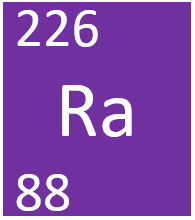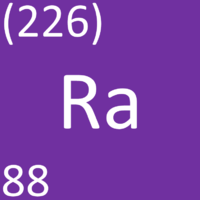Difference between revisions of "Radium"
| Line 20: | Line 20: | ||
==Key Stage 4== | ==Key Stage 4== | ||
| + | [[File:RaKS4.PNG|right|200px|thumb|The [[Chemical Symbol|chemical symbol]] for [[Radium]].]] | ||
===Meaning=== | ===Meaning=== | ||
[[Radium]] is a [[Group 2]] [[element]], on the [[Periodic Table]], with 88 [[proton]]s in the [[Atomic Nucleus|nucleus]]. | [[Radium]] is a [[Group 2]] [[element]], on the [[Periodic Table]], with 88 [[proton]]s in the [[Atomic Nucleus|nucleus]]. | ||
Latest revision as of 14:43, 5 March 2020
Contents
Key Stage 2
Meaning
Key Stage 3
Meaning
Radium is a Group 2 element, on the Periodic Table, with an atomic number of 88.
About Radium
Molecular Structure
- Radium has the chemical formula Ra.
- Radium atoms join together in large numbers to form a giant metal molecule.
Atomic Structure
- Radium as 88 protons and 138 neutrons in its nucleus giving it an Atomic Number of 88 and an atomic mass of 226.
- An atom of Radium has only 2 electrons in its outer shell.
Properties
- Radium is the most reactive alkali earth metal.
- Radium is more reactive than Carbon on the reactivity series so it must be extracted from its ore using electrolysis.
- Radium reacts strongly with water to produce Hydrogen gas and Radium Hydroxide and strongly with acid to produce Radium salts.
- Radium is a solid at room temperature.
Key Stage 4
Meaning
Radium is a Group 2 element, on the Periodic Table, with 88 protons in the nucleus.
About Radium
- Radium was discovered by Marie Curie.
Molecular Structure
- Radium has the chemical formula Ra.
- Radium atoms join together in a giant metallic structure.
Atomic Structure
- The most stable isotope of Radium has 138 neutrons in its nucleus giving it an atomic mass of 226.
- An atom of Radium has only 2 electrons in its outer shell.
- Radium ions have lost two electrons to become positively charged.
Properties
- Radium is the most reactive alkali earth metal.
- Radium is more reactive than Carbon on the reactivity series so it must be extracted from its ore using electrolysis.
- Radium reacts strongly with water to produce Hydrogen gas and Radium Hydroxide and strongly with acid to produce Radium salts.
- Radium is a solid at standard temperature and pressure.

